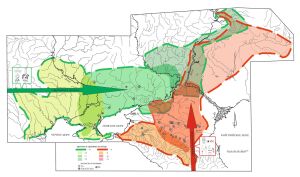 Roman A. Mimokhoda,#, EvgenyI. Gakb.##, Tatiana E. Khomutovac,###, Natalia E. Ryaboginad,####, Alexandr V. Borisovc,#####
Roman A. Mimokhoda,#, EvgenyI. Gakb.##, Tatiana E. Khomutovac,###, Natalia E. Ryaboginad,####, Alexandr V. Borisovc,#####
a Institute of Archaeology RAS, Moscow, Russia
b The State Historical Museum, Moscow, Russia
c Institute of Physicochemical and Biological Problems in Soil Science RAS, Pushchino, Russia
d Institute of the Problems of Northern Development, Siberian Branch of RAS, Tyumen, Russia
#E-mail: mimokhod@gmail.com
##E-mail: e.i.gak@mail.ru
###E-mail: khomutova-t@rambler.ru
####E-mail: nataly.ryabogina@gmail.com
#####E-mail: a.v.borisovv@gmail.com
Keywords: the Middle–Late Bronze Age, the East European forest-steppe, the Caucasus, the Carpathian-Danube region, paleoclimate, migration, cultural genesis, metal production, metallurgical provinces.
The paper presents a comprehensive analysis of the issues of cultural genesis, paleoecology, metallurgy and metalworking during the period of transition from the Middle to Late Bronze Age in the steppe and foreststeppe zone of Eastern Europe. The data obtained, combined with Russian and foreign studies, make it possible to re-evaluate the causes and consequences of the processes that led to the formation of the cultural and historical situation of the Late Bronze Age. The study shows that climatic events of the late 3rd millennium BC and the associated deterioration of winter conditions caused two cultural outbursts from Central Europe and the Caucasus to the East European steppe and forest-steppe zone up to the boundary of forests. This was followed by the disintegration of community of catacomb cultures and arising on its basis of a block of postcatacomb cultural formations (PCB) – the Babino and the Lola cultural circles (2200–2000 CalBC). Humidization of climate in the period between 2000–1800 CalBC provoked a sharp decline in population in desert steppes, which hindered the transit of Caucasian metal further northward, to the bearers of chariot cultural formations that were developing in the steppe and forest-steppe. The reduced flow of Caucasian materials could not satisfy the demands of rapidly developing militarized societies of chariot ultures, as a result of which the demand for the Ural metal increased sharply. This led to a reorientation of the vectors of cultural influences and eventually to a change in ages and metallurgical provinces.
DOI: 10.31857/S0869606322010159







